
Project Overview
Investment:
Participating Groups:
GRDC
Stirlings to Coast Farmers & Southern Dirt
Project Duration:
Project Host(s):
Three year (2018-2020)
- 2018: Ladyman – Carrolup (Year 2 of 2-year trial)
- 2019: Craig Bignell – Broomehill (Year 1 of 2-year trial)
- 2019: Ben Webb – Muradup (Year 1 of 1-year trial: extension to be requested)
Research Authors:
Nathan Dovey, Stirlings to Coast Farmers, and Emma Russell, Southern Dirt
Key Points
Yields (t/ha) of legume crops and gross revenues ($/ha) were lower in the control crops (canola) at Frankland and Kojaneerup. However, the value of the nitrogen fixed by the legumes crops is yet to be measured. This will improve the gross value of legumes.
The late break to the 2018 season made for tough growing conditions for most crops, including legumes.
The price for faba beans was exceptional, which combined with suitable agronomy made them the most profitable legume option from the 2018 demonstrations.
Field peas achieved relatively high biomass in 2018 before lodging and becoming difficult to harvest. Harvesting with a conventional draper front lead to yield losses.
Lentils were difficult to harvest because they were so short with a high risk of rocks in the grain yield.
Project Aim
This project aims to quantify the whole system benefits that legumes can bring to growers cropping phase of the rotation. By quantifying and communicating the benefits of growing legume crops the project aims to increase farmer confidence in planting pulses and ultimately increase the number of hectares planted in the Albany Port Zone.
The Legumes demonstration also aims to raise awareness of the new crop types and varieties available to growers that have vastly improved agronomic traits. Growers from previous generations could have poor experiences with legumes crops and this project aims to reintroduce the idea of trying to grow legume crops as a break crop.
Preliminary Findings:
The 2018 Carrolup site was sown with Jurien Lupins, Bolt Lentils, Samira Faba Beans and Striker Chickpeas. Dry sowing conditions and poor weed control reduced yield potential. In 2019, the site was seeded to Planet Barley with site evaluations ongoing to determine any benefits from the previous year’s legume crops.
Two sites were established in 2019:
Broomehill: Samira Faba Beans, Jurien Lupins, Bolt Lentils and Striker Chickpeas (Ora Peas surround trial site).
Muradup: Farah Faba Beans, Jurien Lupins, Eliza Serradella, Timock Vetch.
Project Background
Grain growers in the Albany port zone lack diversity during the cropping phase with a canola-barley rotation the most frequently grown. Growers and agronomists are now encountering serious fungicide, and to a lesser degree, herbicide resistance problems in canola and barley crops. Adding a legume to the cropping phase is one option to improve diversity which will have soil health, disease and weed benefits that should ultimately help farmers maintain or improve overall crop yields.
Legume crops are highly valued in the region given most businesses are mixed farming enterprises where pulse grains are used for livestock feed. Legume crops fix extra nitrogen to the soil for the following seasons crop. The different chemistry options to control disease and weeds mean farmers can rotate to different modes of action that will lengthen their effectiveness.
The problem with legumes traditionally has been that they struggle to be profitable in most seasons. They only appear to turn a profit during higher than average yields and/or prices. Growers need compelling reasons to include them in their cropping program when the profits are so much lower than other possible farming enterprises.
The Frankland Legume Demonstration - Simon Hilder Site
| Results | |
|---|---|
| Soil Testing: | Tests showed soil pH to be 5.5 (CaCl2) In the 0-10 cm layer and 5.0 (CaCl2) in the sub-soil which is adequate for legume crops. |
| Paddock History: | 2017: Wheat; 2 t/ha lime applied; 2016: Lupins; 2015: Barley; Tree stumps removed in January; 2 t/ha lime applied |
| Soil Description: | Moderately deep loamy gravel, well drained and water repellent. |
| Suitability for legumes: | Well suited on the free draining slopes. Not suitable for lower parts of the landscape. |
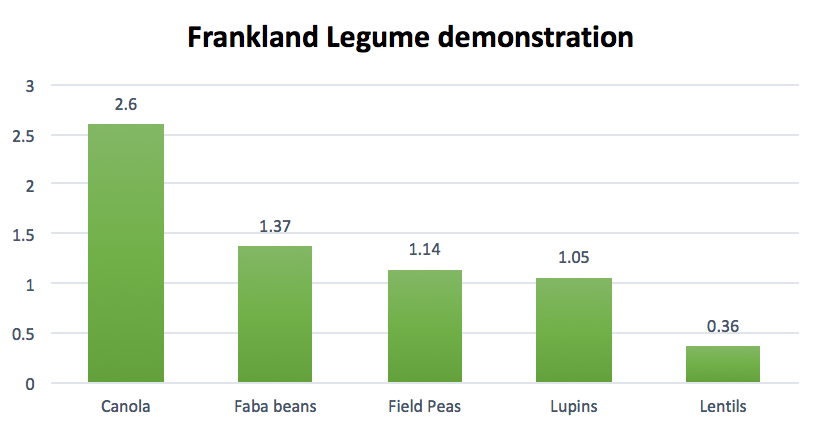
Figure 1: Summary of the grain yields achieved at the Frankland demonstration site (Simon Hilder). The figures indicate the t/ha of grain yield for each crop. Trial was sown on the 5th of May 2018.
The Kojaneerup Legume Demonstration - Mark Slattery Site
| Results | |
|---|---|
| Soil Testing: | Tests showed top-soil (0-10cm) pH to be 6.1, 4.7 and 4.9 in CaCl2. A pH of 6.1 is excellent whereas 4.7 and 4.9 are not ideal soil pH’s for legumes to grow. This could have restricted plant growth and nitrogen fixation. Organic carbon levels were 1.16, 2.03 and 2.25% indicating a reasonable level of soil fertility. |
| Paddock History: | 2017: Barley 2016: Canola 2015: Barley |
| Soil Description: | Grey shallow sandy duplex, strongly water repellent |
| Suitability for legumes: | Top-soil pH levels below 5 CaCl2 are not ideal for legume crop growth. The legume yields were not better where the top-soil pH was over 6 CaCl2. |
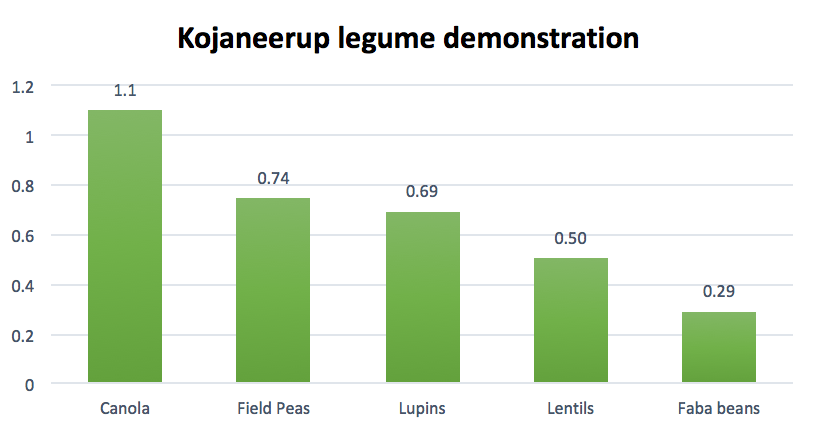
Figure 2: Summary of the grain yields recorded at the Kojaneerup legume demonstration site (Slattery). The figures indicate the tonnes/ha of grain yield for each crop. Trial was sown on the 24th May 2018.
Carrolup Legume Demonstration - Rob Ladyman Site
| Results | |
|---|---|
| Soil Testing: | Top-soil pH was 4.8 CaCl2, which is not ideal for legume crops. The soil pH at 10-20 cm and 20-30cm was 4.5 CaCl2 and 4.6 CaCl2, indicating reasonable soil pH in the sub-soil. |
| Soil Description: | Grey deep sandy duplex, with abrupt clay increases down the profile. |
| Suitability for legumes: | Soil pH remained above 4.5 CaCl2 in the sub-soil which is useful for legume crops. Ideally top-soil pH would be over 5.5 CaCl2 to optimise legume growth. |
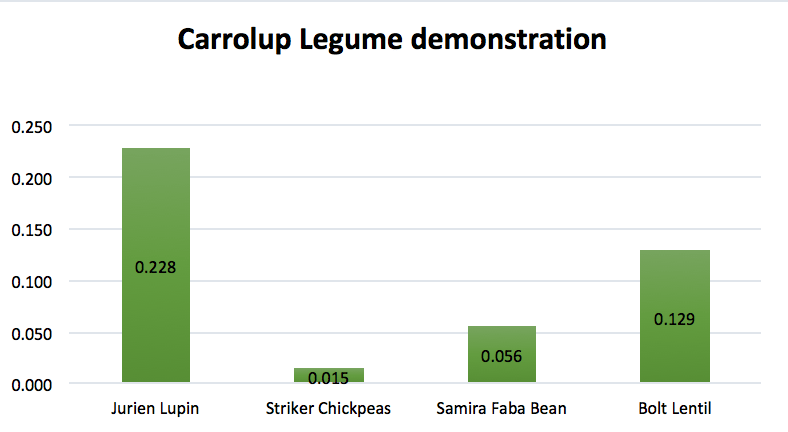
Figure 3. Summary of the grain yields achieved at the Carrolup legume demonstration site (Ladyman). The figures indicate the t/ha of grain yield for each crop. Trial was sown on the 29th May 2018.
Comments
Legume yields were inferior to canola at the Frankland and Kojaneerup demonstration sites in 2018. Importantly, the same pattern was observed for gross revenue ($/ha), although faba beans were competitive, at the Frankland site. However, at the time of writing up the results, the value from the amount of nitrogen fixed from each legume was yet to be tested. This will improve the value of growing legume crops when this is factored into the legume package.
The faba bean price was calculated at $1000/tonne on 6th March 2019. This exceptional price made faba beans gross revenue comparable with canola, although still $116/ha less than the Clearfield canola crop. Growers should not expect to see faba bean prices consistently this high.
The demonstration site at Carrolup yielded so poorly it was impossible to make any sound yield observations in 2018. Due to the late break, the grower hosts switched the surrounding crop to barley. Plant numbers at Carrolup indicated that the germination of all four crops was adequate, with all of them reaching recommended plant establishment numbers from Pulse Australia (see table 1).
| Kojaneerup | Frankland | Carrolup | Recommended | |
|---|---|---|---|---|
| Treatment | Plants per m2 | Plants per m2 | Plants per m2 | Plants per m2 |
| Jurien Lupin | 14b | 21a | 56 | 45 |
| Striker Chickpeas | 31 | 20-30 | ||
| Samira Faba Bean | 13b | 29a | 23 | 20.35 |
| Bolt Lentil | 43a | 59a | 112 | 100-120 |
| Kaspa field peas | 22b | 30a | 40-50 | |
| LSD P=0.05 | 15 | 27.154 | ||
| Standard Deviation | 9.4 | 8.532 | ||
| CV | 40.5 | 24.56 |
Means followed by the same letter or symbol do not significantly differ (P =0.05, LSD)
Table 1. Plant count numbers recorded at the three Legume Demonstration Sites in 2018. Recommended plant numbers (m2) from Pulse Australia are shown in the far-right column.
| Kojaneerup | Frankland | Carrolup | ||||||
|---|---|---|---|---|---|---|---|---|
| Treatment | YIELD T-MET | Revenue ($/ha) | YIELD T-MET | Revenue ($/ha) | YIELD T-MET | Revenue ($/ha) | ||
| Jurien Lupin | 0.69a | 243 | 1.05a | 369 | 0.23a | 80 | ||
| Striker Chickpeas | 0.015a | 11 | ||||||
| Samira Faba Bean | 0.29c | 289 | 1.37a | 1366 | 0.056a | 56 | ||
| Bolt Lentil | 0.50b | 267 | 0.36a | 193 | 0.13a | 68 | ||
| Kaspa field peas | 0.74a | 417 | 1.14a | 640 | ||||
| Canola control | 1.10 | 627 | 2.60 | 1482 | ||||
Means followed by same letter or symbol do not significantly differ (P=.05, LSD).
Table 2. Summary of grain yields (t/ha) from the three legume sites in 2018. Table shows the gross revenue ($/ha) of the crops from each location. Grain prices were calculated on the 6th March 2019, delivered Perth. Canola $570, chickpeas $750, faba beans $1000, field peas $560, lentils $530, and lupins $350.
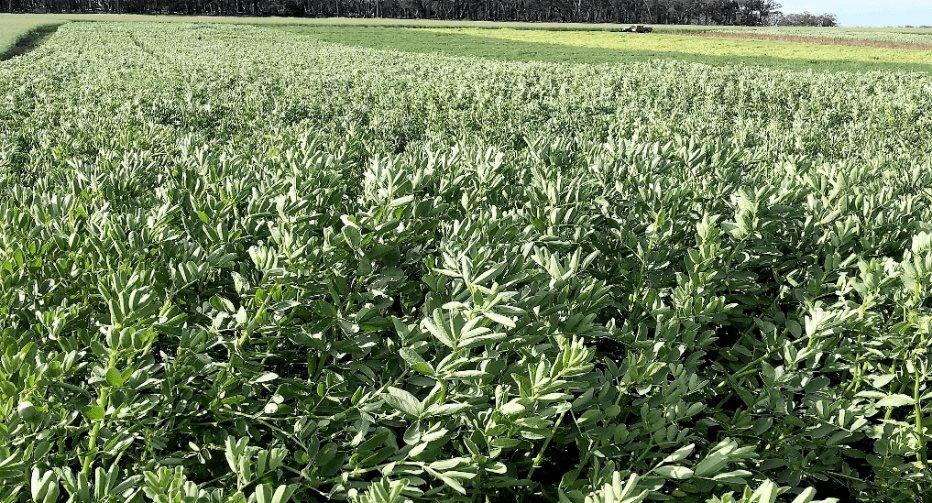
Figure 4. Photograph of Samira faba beans at Frankland on the 18th October 2018. The demonstration site had a small patch of waterlogging in 2018 which the faba beans tolerated better than the other pulse crops.
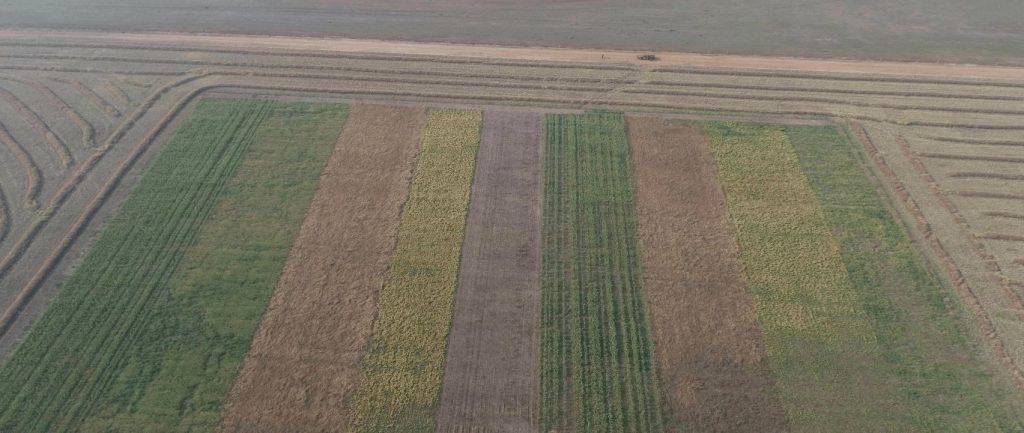
Figure 5. Aerial image of the Frankland legume demonstration site taken on the 8th November 2018. The striped plots are the faba bean replicates where some of the seed blocked the air- seeder tubes.
Conclusions
018 was characterised by a dry start to the season which reduced the yield potential of legumes greatly. The demonstration at Frankland recovered well and even suffered some water logging damage in a low-lying part of the trial. This site showed a high yield potential, especially for the faba beans and the field peas. Late frosts in October and November may have impacted on final yields, as well as severe lodging in the field peas restricting the harvest process. The field peas also had stones and gravel in the grain sample which may have restricted sales to livestock owners only. Cleaning is an option, however not always effective at removing enough rocks to be deliverable for export use.
The 2018/19 faba bean price was extraordinarily high due to very limited supply and high demand. Farmers would be unwise to expect such high prices every year. Though, the high prices were able to off-set the lower yield in comparison to canola, to produce a similar gross revenue at the Frankland site. The farmer host, Simon Hilder, thinks there is more yield potential to achieve from faba beans in a more conducive season. Simon is optimistic that faba beans could become part of his family’s cropping rotation in the future.
Despite the legume phase of this project being complete, Simon Hilder would like to repeat the demonstration strips in 2019 at Frankland and continue gathering data whilst also implementing lessons learnt in 2018. Simon plans to grow lupins, field peas and faba beans again in 2019 with help from SCF to assess their fit to his farming system. Simon has ruled out lentils as a viable option on his farm. Some of the improvements we hope to make in 2019 will be,
Sourcing crop lifters for the header front so we can collect the field peas better;
Changing his liquid fertiliser system on the air- seeder, which contributed to the seed blockages in the faba beans;
Seeding the faba beans into moist soil and sowing at a slower ground speed;
Using Terbuthylazine, a pre-emergent chemical to control cape-weed.
The Kojaneerup demonstration site was extremely dry for most of 2018 and the legume crops did not emerge until late June. 2018 was a very rare season for this area which typically records mean annual rainfall figures 500 mm and over. The area also suffered strong winds on three separate occasions which caused wind erosion in many of the lighter paddocks. All plant numbers were below recommended densities, according to the Pulse Australia website, due to the conditions mentioned above.
The highest yielding legume at the Kojaneerup site was the kaspa field peas at 0.74 t/ha. A price of $560/tonne gives a gross revenue of $417/ha which is $210 below the canola control (1.1 t/ha at $570/t). Given the extremely tough season, the relative yield of the field peas was better than expected. We look forward to repeating this trial in the Kojaneerup region in 2019, and hopefully experiencing some kinder growing conditions.
The Carrolup demonstration site suffered from a dry season and poor weed control. Perhaps the best outcome from this trial was to highlight how important timely weed control is for all pulse crops. Grains yields were too low to make any other meaningful observations. This trial will be repeated in season 2019, with hopes for an earlier break to the season.
Implications
We experienced many of the challenges that growers are faced with when growing pulse crops in 2018. Ideally, pulse crops need to be sown early to maximise yield potential. There was not an opportunity to do that at the three demonstration sites last year. Aside from reduced yield, we also encountered heavier weed burdens, due to reduced plant competition and poorer chemical efficacy.
Thankfully, the Frankland trial site experienced a reasonable growing season despite the late start. This enabled us to see the true potential of Faba beans, Field Peas and even Lupins to a lesser degree. We still encountered many of the traditional difficulties with growing legume crops such as:
- Getting rocks in the grain sample
- Getting blocked seeder tubes due to the very large Samira Faba bean seed
- Heavy lodging of Field Peas making them difficult to harvest
- Lack of in-crop herbicide options to control broad-leaf weeds.
- Poor nodulation due to the dry conditions at seeding and immediately after
- Poor yields in comparison to the established break crop ‘canola’.
Despite these difficulties, SCF and SD growers understand the overall importance to increasing crop diversity. This message will be further clarified when we host the Farmanco Crop Sequencing and Modelling work-shops in 2019 and 2020. The high prices achieved by Faba beans in 2019 will generate interest in legume crops despite growers understanding 2018 was a rare year for grain prices.
Results from the 2018 Frankland site indicate that Field Peas and Faba beans require further investigation. Large areas of the Faba beans had exceptional biomass and the Field peas also had consistent biomass over the growing season. Both crops probably lost yield from the late frost events and we know that the header front used was unable to pick up 100% of the Field peas. By addressing most of the issues listed above we hope to improve yields and gross margins to close the gap on canola as break crop. We also need to assess the yield potential of these crops when sown in their preferred seeding window.
Acknowledgements
Thank you to Grains Research & Development Corporation for investing in this project.
Thank you to the growers for hosting the trials Simon Hilder (Frankland), Rob Ladyman (Carrolup), and Mark Slattery (South Stirlings).

